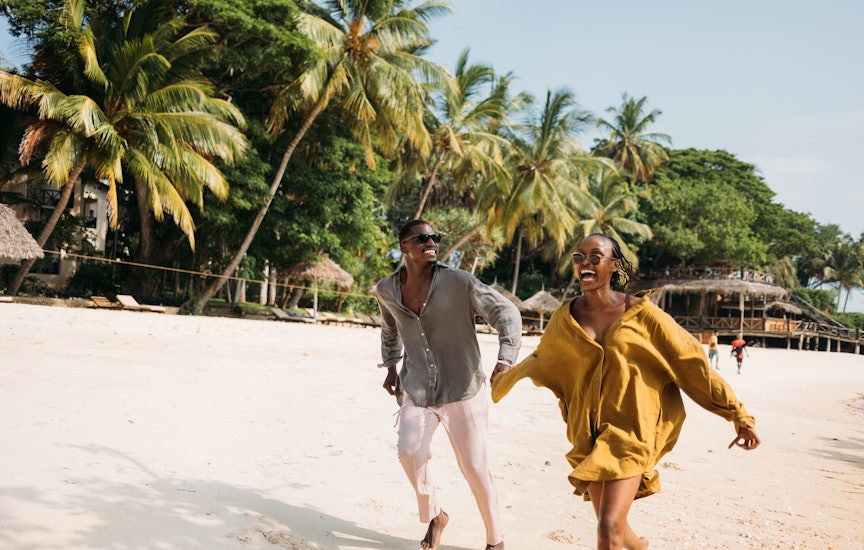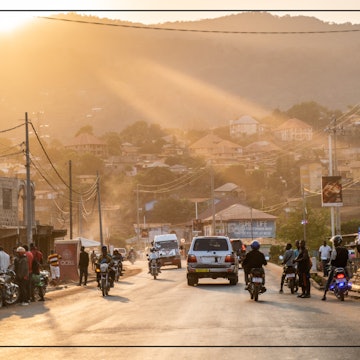

A road near Makali in the rainy season, Sierra Leone. robertonencini/Shutterstock
For a small country, Sierra Leone has no shortage of fabulous places to visit. Indeed, depending on the length of your trip, your biggest challenge may well be deciding which ones to leave off your itinerary. (All the more reason to plan a return visit.)
Even so, it’s easy to see the highlights of Freetown and the surrounding peninsula on a relatively short timeline. Some of the country’s top attractions – like Outamba-Kilimi National Park, Tiwai Island or the Turtle Islands – are harder to reach; still, you can comfortably visit one or two on a two-week trip.
As you start planning your trip to Sierra Leone, consider our list of the top places to visit.

1. The Freetown Peninsula
Best for lazing on the beach
With crystal-clear waters, slender palm trees and soft-sand beaches curving toward the horizon, the Freetown Peninsula is one of the top beach destinations in all of Africa. Less than an hour from Freetown city center by car, the coast makes for an easy road trip. The peninsula is stunning: pockets of rainforest meet the saffron sand, where beach restaurants offer grilled fish and lobster splashed with lime, and local fruit vendors crack open coconuts for visitors. The whole place is so dreamy that it has starred in many television commercials – yet it’s enough off the beaten track enough that a weekend here still feels like happening upon a secret.
Franco’s, a legendary beach restaurant at River Number Two Beach, is one of the best spots on the peninsula for grilled fish, washed down with a Star beer or glass of wine. Nearby Cockle Point is a small eco-friendly beach spot with pretty wooden bungalows. On Tokeh Beach, The Place is a higher-end resort with a marine aesthetic. You can surf at many of the beaches as conditions allow; look for surf clubs dotted along the rocky shore.

2. Tacugama Chimpanzee Sanctuary
Best for supporting local conservation initiatives
Nestled within a lush forest framed by waterfalls in the Western Area Peninsula National Park just outside Freetown, this 100-acre sanctuary – founded by Sri Lankan conservationists Bala and Sharmila Amarasekaran – provides a safe haven for endangered primates. Many of its residents are orphaned chimpanzees, survivors of deforestation or rescues from the pet trade. The chimps you’ll see here live in different groups and all have individual names (say hi to Ramba, Kabala, Rasta and Sarah for us). Daily tours take you through the forest to spot them, or to serve them supper, along trails visited by stunning butterflies and birds.
At the forefront of vital community-outreach efforts, the refuge works tirelessly to prevent the extinction of wild chimpanzees, whose survival is increasingly threatened by habitat loss on the peninsula and in other parts of Sierra Leone. You can support the mission by joining one of the daily tours or by spending the night in a round eco-hut, drifting off to sleep to the sounds of the forest.
3. The Turtle Islands
Best for desert-island dreaming
If camping under the stars on gorgeous remote beaches is your thing, take the three-hour speedboat ride from the Freetown Peninsula to the Turtle Islands. These eight specks are mostly home to fishing communities populated by the Sherbro ethnic group, who have held onto a traditional way of life. The beaches are lined with mangroves and palm trees, while dolphins play offshore, among tropical fish and flotillas of sea turtles. Spend your days here swimming or snorkeling in the ocean, catching up on rest in a hammock and tucking into grilled lobster as the sun goes down. The local community also offers performances of traditional dance and drumming.
There are eight small islands in the archipelago: Baki, Bumpetuk, Chepo, Hoong, Mut, Nyangei, Sei and Yele. Most visitors arrive at Baki, a picture-perfect island of golden sands, swaying palms, and scattered seashells, cooled by the Atlantic breeze. The speedboat journey takes about three hours each way, depending on tides and weather conditions. Fully catered camping trips are organized by Daltons Banana Island Guesthouse – and such organized trips include gaining permission to visit from the local village chiefs, an important part of visiting the Turtle Islands. Note that some of the islands, like Hoong, hold deep spiritual significance and are reserved for traditional rites of passage, making them off limits to visitors.

3. Bunce Island
Best for learning about the history of slavery
Tiny Bunce Island lies 19 miles (30km) up the river from Freetown, a 45-minute speedboat ride away. This small speck carries a haunting history, for it was a major station for the trade of enslaved people between 1670 and 1807. During this timeframe, British enslavers kidnapped and forced more than 30,000 people through the Door of No Return and on to the Americas; the island had earlier been a center for Portuguese slave traders. With its overgrown castle ruins, the island is now a site of remembrance – and a painful place to visit, especially for those who have traced their family ancestry back to Sierra Leone. The only way to visit is by guided tour from Freetown; tours usually stop at a neighboring island for passengers to refuel, as there’s nowhere to sleep or eat on Bunce.

5. Historic Freetown
Best for architecture and history buffs
Covering a series of hills overlooking the ocean, Freetown is a charming capital with an exuberant spirit. Head to the historic downtown area to take in striking architecture and dive into the history of this seaside city.
A great first stop is the Sierra Leone National Museum on Siaka Stevens St, Its two galleries house a permanent collection of cultural and historical artifacts, including a rare photograph of Temne guerrilla leader Bai Bureh, who led the 1898 uprising against the British colonizers. The second gallery hosts rotating exhibitions on subjects including photography and anthropology.
Next, wander over to Tower Hill, overlooking downtown Freetown. There, State House is a striking example of old Krio architecture, with brightly painted buildings and window frames incorporating elements of the original fort built at the turn of the 19th century. At the National Railway Museum on Cline St, you can learn about plans to restore Sierra Leone’s railways and see a carriage commissioned for Queen Elizabeth II in 1961. (In the end, she never stepped inside it – but you can.) The museum also features a handcar ride and a photography exhibition.
About 15 minutes away on foot is Big Markit, which has been serving shoppers since the 18th century. Behind the lovely curved arch doorway are Sierra Leonean textiles including beautiful bedspreads, woven shoes and Temne shukublai baskets – as well as jewelry and other arts and crafts.
6. Outamba-Kilimi National Park
Best for seeing Sierra Leone’s “Big Five”
Beneath a dense forest canopy in the north of the country, Outamba-Kilimi National Park involves a long road trip toward the border with Guinea – one well worth the journey. The park has been protected since 1995, and takes its name from its defining landmarks, Outamba Mountain and the Kilimi River. The protected landscapes – woodlands, savannahs and riverine forests – are home to a wealth of wildlife. Don’t expect safari vehicles or tour buses: wildlife watching here takes place on foot or by canoe, a more intimate experience. Rangers can arrange day or overnight hikes and canoe safaris.
The park has its own quintet of charismatic animals to look out for: forest elephants, western chimpanzees, buffaloes, Sierra Leonean common hippos (larger than pygmy hippos but smaller than their East African counterparts), and a small but elusive leopard population. Depending on the time of year, you might spot red colobus monkeys swinging through the trees, or migratory birds soaring over the river. With over 300 bird species, the park is a haven for bird-watchers.
The park is the current focus of conservation efforts led by the Sierra Leonean government, the Tacugama Chimpanzee Sanctuary and international partners, who are working to restore biodiversity impacted by recent deforestation. You might spot some of their initiatives on a visit here, including camera traps, fire belts to prevent wildfires and conservation-education efforts in nearby communities. Note that the park is easiest to reach during the dry season; in the rainy season, access may be hampered by roads clogged with mud.

7. Tiwai Island
Best for moonlit hikes
Its name, which means “big island” in the Mende language, is a bit of a misnomer – for Tiwai Island takes up just 4⅔ sq miles (12 sq km). Yet small as it is, this pristine sanctuary is the kind of place anyone lucky enough to visit will talk about for years. Situated along the Moa River, the island is one of the last pieces of the lowland tropical forests that once covered much of West Africa.
Rich in biodiversity, Tiwai is a community-led conservation project and wildlife sanctuary, sharing a stretch of ancient rainforest with Gola Rainforest National Park near Kenema. (Both are currently under consideration for UNESCO World Heritage status.) The reserve is home to Sierra Leone’s highest concentration of primates, including western chimpanzees and black-and-white Diana monkeys, not to mention bush babies and 135 bird species. Its humid, wet climate provides the perfect habitat for the elusive pygmy hippo (although the species is shy and sightings rare). Other wildlife includes forest elephants, otters, sea turtles and over 700 species of plants.
Access to the island is by speedboat or dugout canoe from the village of Kambama, off the Potoru–Tiwai highway. Once on the island, each group gets assigned a local guide, who may also double as a cook. Guided forest walks offer the chance to spot monkeys and, with a bit of luck, chimpanzees. There are night walks under the stars, dugout-canoe safaris, guided beach walks and chimpanzee tracking. For independent exploration, a few self-guided forest trails wind through the island’s lushness.













